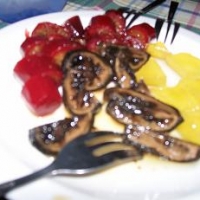Spoon Sweets
Spoon sweets are sweet preserves, served in a spoon as a gesture of hospitality in the Balkans, the Middle East, and in Russia. They can be made from almost any fruit, though
...More
sour and bitter fruits are especially prized. There are even spoon sweets not made from fruit at all.
Some of the fruits that are used include grapes, mulberries, bergamot, apricots, cherries, oranges, lemons, pomegranates, quinces, figs, prunes, and tangerines. Other varieties include vegetables, pistachios, hazelnuts, and other nuts, and flower petals like rose. Many fruits or parts of fruits that are normally inedible, such as citrus peel, can be made into sweet, flavorful preserves, as can unripe nuts and vegetables such as eggplant. Spoon sweets usually retain the original shape, color, aroma and taste of the fruit.
Traditionally nearly all spoon sweets were made crunchier but putting in the water 1/2 glass of quicklime with the fruit. They let it rest for two or more hours and then washed the fruit very well and proceeded to made the sweet.
Spoon sweets are usually offered to guests served by the teaspoon in a small china or crystal dish, with coffee or tea and cold water. Most of the time they are homemade, but nowadays they can also be easily found in most supermarkets.
They can be used as ice cream toppings, in cakes, mixed with yogurt, or in the Western way as a spread on toast for breakfast.
Greece and Cyprus
Spoon sweets (γλυκό του κουταλιού 'sweet of the spoon') are popular in Greece and Cyprus, usually served with Greek coffee and a glass of cold water. Most are made of whole fruit, though some kinds are made of pieces or purees.
One typically Greek spoon sweet is the intensely flavoured Βανίλια [va'nilja], which is not made of vanilla, but of mastic resin, for which the Aegean island of Chios is famous. This is usually served as a spoonful of sweet on a spoon dropped into a tall glass of water and called βανίλια υποβρύχιο 'vanilla submarine'. The Greek diaspora (ex pats) introduced this treat to other countries as far away as Japan. It is said to be the official treat of the Orthodox Patriarchate.
Whole fruit preserves can be found in most Greek and Cypriot homes. They are made by slowly boiling fruit in water and sugar over several hours or days, until the syrup sets. A small quantity of lemon juice is often added to preserve the fruit's original color, as the citric acid prevents oxidation. The method of preparation is essentially similar to that of marmalade, except that fruit pieces remain whole.
In the picture the black one is fresh walnut, the red one is eggplant and the yellow one is water melon after the outer part is peeled.
No discussions. Why not start one?
Group Details

- Creator
-
ivy
- Type
- Public
- Members
- 5
- Age
- 18 years ago
- Activity
- low
- Membership
- Join the Group
Just Added
-
ivy Whereabouts, Unknown Added Bergamot Spoon Sweet
-
ivy Whereabouts, Unknown Added Nerantzi Glyko - Bitter Orange Preserve
-
ivy Whereabouts, Unknown Added Glyko Karydaki - Fresh Walnuts In Syrup
